order: 5
Interpretation
Once DE genes have been identified, the next crucial step is to interpret the results. This involves the inspection of tables and plots generated during the analysis to understand the biological significance of the data. In this part of the tutorial, we will explore the results by discussing the significant DE genes and we will examine various plots generated during the analysis.
The results illustrated in this section might show slight variations compared to your runs due to randomness in the STAR algorithm. This randomness arises from using variable seed values and parallel processing, leading to minor differences in results between runs on the same data. These small discrepancies are not biologically significant and may affect counts and subsequent plots (such as PCA and count plots). However, the overall patterns and main findings should remain consistent. While exact reproducibility is ideal, minor variations are acceptable in practice, as long as they do not impact the main conclusions of the study.
Quality control plots
The first plot we will examine is the Principal Component Analysis (PCA) plot. Since we’re working with simulated data, our metadata is relatively simple, consisting of just three variables: sample, condition, and replica. In a typical RNA-seq experiment, however, metadata can be complex and encompass a wide range of variables that could contribute to sample variation, such as sex, age, and developmental stage.
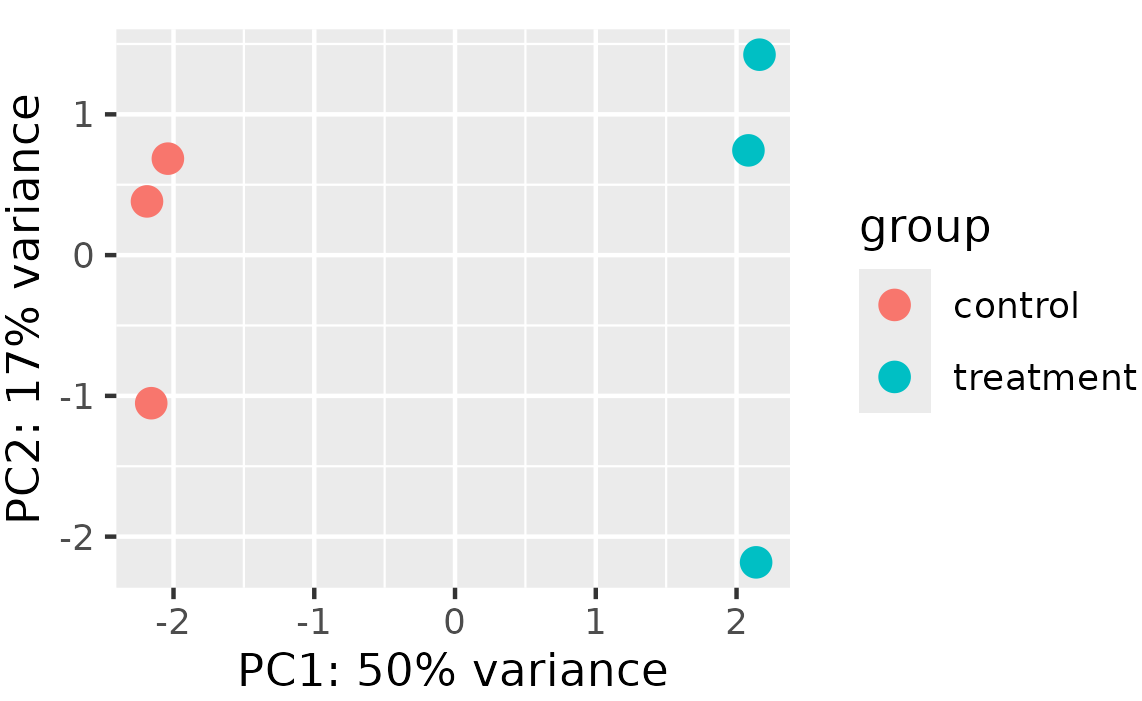
By plotting the PCA on the PC1 and PC2 axes, using condition as the main variable of interest, we can quickly identify the primary source of variation in our data. By accounting for this variation in our design model, we should be able to detect more differentially expressed genes related to condition. When working with real data, it’s often useful to plot the data using different variables to explore how much variation is explained by the first two PCs. Depending on the results, it may be informative to examine variation on additional PC axes, such as PC3 and PC4, to gain a more comprehensive understanding of the data.
Next, we will examine the hierarchical clustering plot to explore the relationships between samples based on their gene expression profiles. The heatmap is organized such that samples with similar expression profiles are close to each other, allowing us to identify patterns in the data.
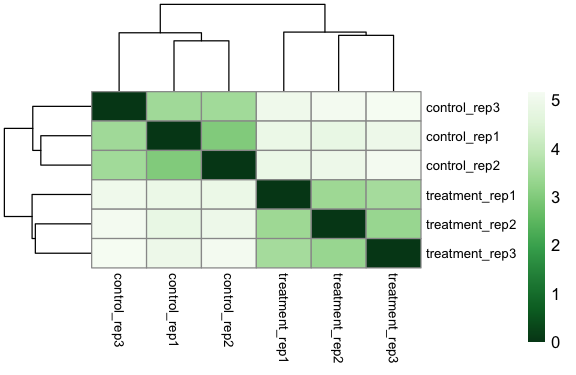
Remember that to create this plot, we utilized the dist() function, so in the legend on the right, a value of 0 corresponds to high correlation, while a value of 5 corresponds to very low correlation. Similar to PCA, we can see that samples tend to cluster together according to condition, indeed we can observe a high degree of correlation between the three control samples and between the three treated samples.
Overall, the integration of these plots suggests that we are working with high-quality data and we can confidently proceed to the differential expression analysis.
Differential expression results
In this part of the tutorial, we will examine plots that are generated after the differential expression analysis. These plots are not quality control plots, but rather plots that help us to interpret the results.
After running the results() function, a good way to start to have an idea about the results is to look at the MA plot.
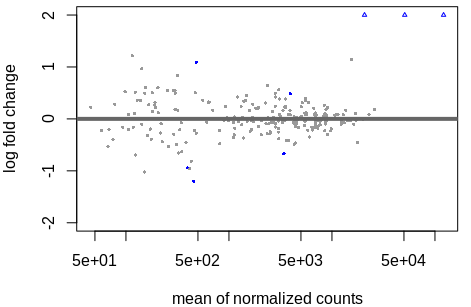
By default, genes are coloured in blue if the padj is less than 0.1 and the log2 fold change greater than or less than 0. Genes that fall outside the plotting region are represented as open triangles. At this stage, we have not yet applied a filter to select only significant DE genes, which we define as those with a padj value less than 0.05 and a log2 fold change of at least 1 or -1.
After filtering our genes of interest according to our threshold, let’s have a look to our significatnt genes:
gene baseMean log2FoldChange lfcSE stat pvalue padj
ENSG00000205726 121645.5908 2.894480 0.1515387 19.100600 2.496005e-81 5.840651e-79
ENSG00000142192 51065.3192 3.025489 0.1891258 15.997230 1.335883e-57 1.562983e-55
ENSG00000142156 20805.8078 2.977705 0.2159277 13.790287 2.915972e-43 2.274458e-41
ENSG00000159231 458.9277 -1.194777 0.3058100 -3.906926 9.347790e-05 5.468457e-03
ENSG00000156282 481.7624 1.095272 0.2969594 3.688289 2.257672e-04 1.056590e-02To gain a comprehensive overview of the transcriptional profile, the volcano plot represents a highly informative tool.
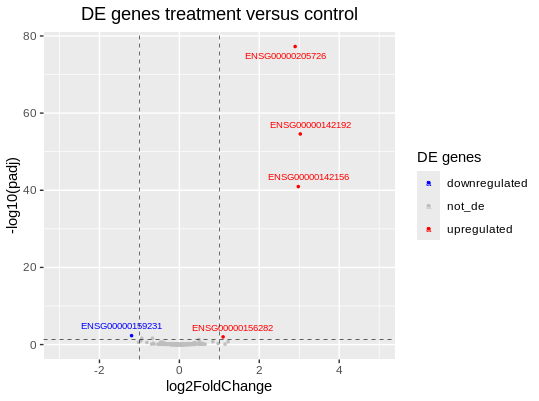
The treatment induced differential expression in five genes: one downregulated and four upregulated. This plot visually represents the numerical results reported in the table above.
After the identification of DE genes, it’s informative to visualise the expression of specific genes of interest. The plotCounts() function applied directly on the dds object allows us to examine individual gene expression profiles without accessing the full res object.
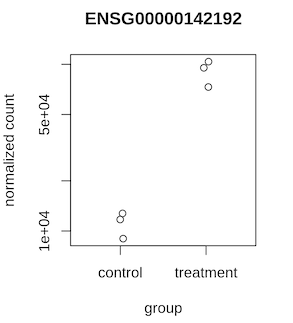
In our example, post-treatment, we observe a significant increase in the expression of the ENSG00000142192 gene, highlighting its responsiveness to the experimental conditions.
Finally, we can create a heatmap using the normalised expression counts of DE genes. The resulting heatmap visualises how the expression of significant genes varies across samples. Each row represents a gene, and each column represents a sample. The color intensity in the heatmap reflects the normalised expression levels: red colors indicate higher expression, while blue colors indicate lower expression.
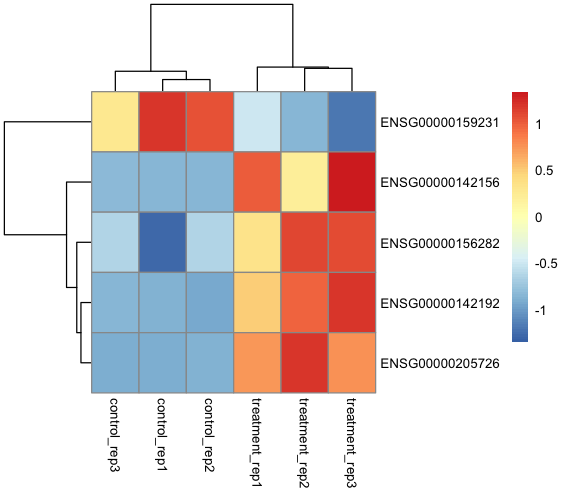
By examining the heatmap, we can visually identify the expression patterns of our five significant differentially expressed genes. This visualisation allows us to identify how these genes respond to the treatment. The heatmap provides a clear and intuitive way to explore gene expression dynamics.
Over Representation Analysis (ORA)
Finally, we can attempt to assign biological significance to our differentially expressed genes through Over Representation Analysis (ORA). The ORA analysis identifies specific biological pathways, molecular functions and cellular processes, according to the Gene Ontology (GO) database, that are enriched within our differentially expressed genes.
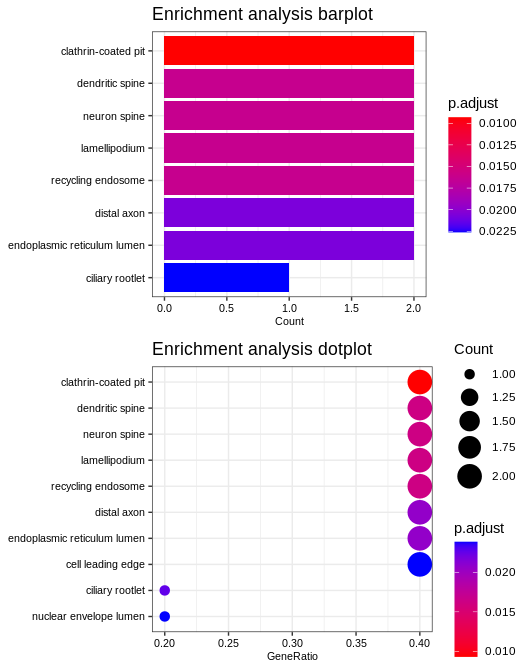
The enrichment analysis reveals a possible involvement of cellular structures and processes, including “clathrin-coated pit”, “dendritic spine”, “neuron spine” and “endoplasmic reticulum lumen”. These terms suggest a focus on cellular transport, structural integrity and protein processing, especially in neural contexts. This pattern points to pathways related to cellular organization and maintenance, possibly playing an important role in the biological condition under study.
Conclusions
In this tutorial, we have walked through the steps of the RNA-seq analysis, from launching the nfcore/rnaseq pipeline to interpreting differential expression results. You learned how the data are generated, identified differentially expressed genes, and conducted enrichment analysis. By following this tutorial, you should now be able to use the nfcore/rnaseq pipeline and perform differential expression analysis with DESeq2, interpreting the results within the context of your research.